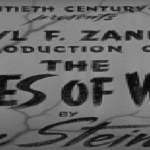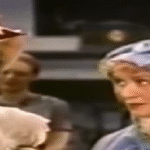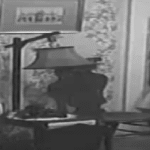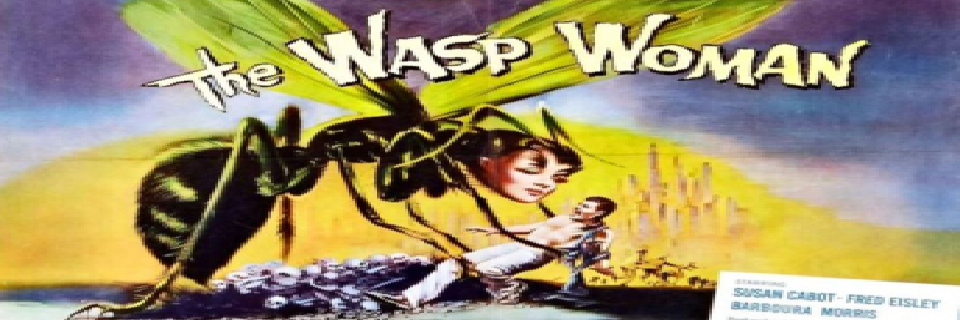The Wasp Woman, a 1959 science fiction horror film directed by Roger Corman, delivers a cautionary tale wrapped in the trappings of low-budget genre cinema. While brief in length and modest in production, the film explores themes of vanity, scientific overreach, and the dangers of unchecked ambition. At its core, it tells the story of a woman determined to recapture her lost youth and beauty, only to fall victim to a horrifying transformation that blurs the line between human and insect.
The film opens in a bustling modern city, where Janice Starlin, a confident and powerful businesswoman, presides over her successful cosmetics empire. She is elegant, well-dressed, and commanding, yet behind her polished exterior lies a growing anxiety. Janice, in her early forties, is acutely aware that her age is becoming a liability in the beauty industry. As the face of her own brand, she feels the mounting pressure to maintain a youthful image in order to remain relevant and continue selling the very products that promise youth to others.
Her concern begins to affect the company’s performance. Sales are dropping, and the board of directors urges her to consider hiring a younger model to represent the brand. Janice, fiercely independent and proud, refuses to be replaced. Instead, she seeks an alternative solution that will allow her to remain the figurehead of her company while defying the natural process of ageing.
Her answer arrives in the form of Dr Eric Zinthrop, a peculiar and somewhat eccentric scientist who claims to have discovered a revolutionary youth serum derived from enzymes extracted from the royal jelly of wasps. Unlike the typical honeybee variety, these enzymes reportedly have incredible regenerative properties. Zinthrop approaches Janice with his findings, and though his methods are unorthodox and his background questionable, Janice is intrigued by the potential of his discovery.
Desperate for results, she agrees to fund his research and bring him into her company’s laboratories. She insists on testing the serum on herself, over Zinthrop’s cautious objections. He warns that the formula is still in the experimental stage and should be tested thoroughly before being administered to humans. Janice, impatient and driven by vanity, disregards his warnings and begins using the serum in secret.
At first, the results seem miraculous. Janice appears more youthful and energised, her skin smoother, her features more vibrant. The transformation impresses her colleagues and rekindles her confidence. She returns to the public eye with renewed vigour, and the company’s fortunes begin to rebound. However, the serum’s effects come at a terrifying cost. Janice begins to suffer blackouts, during which her body undergoes a grotesque metamorphosis. Unbeknownst to her staff, she is gradually transforming into a hybrid creature, part woman, part wasp.
As these blackouts become more frequent, so do the mysterious disappearances within the company. Employees begin to go missing, and strange noises are heard in the night. Zinthrop, growing alarmed by Janice’s behaviour and the irregularities in her treatment, tries to investigate further. However, before he can take action, he is injured in a car accident and left unconscious, unable to warn anyone of the impending danger.
Meanwhile, Janice’s dual existence spirals further out of control. In her monstrous form, she prowls the company building after hours, killing those unfortunate enough to encounter her. The creature she becomes is driven by instinct and aggression, bearing a grotesque wasp-like face and limbs, yet still retaining enough of her human form to inspire pity. The once powerful and elegant woman is now at the mercy of a biological horror she unleashed upon herself.
Two company employees, Mary and Bill, begin to suspect something is amiss. They notice Zinthrop’s absence and the increasingly erratic behaviour of their employer. As the mystery deepens, they eventually uncover the truth behind Janice’s transformation. In a climactic sequence, they confront her in her monstrous state. The confrontation is intense and tragic, as Janice, fully transformed, lashes out in desperation and fury.
The film concludes with a final battle in the laboratory. As Janice attacks, she is killed during the struggle, bringing an end to her reign of terror. Zinthrop, having regained consciousness just in time to witness the aftermath, reflects sorrowfully on the consequences of pushing nature beyond its limits. The closing scene leaves viewers with a sobering message about the cost of vanity and the perils of meddling with forces not fully understood.
Despite its budgetary constraints and limited special effects, The Wasp Woman manages to create a tense and eerie atmosphere, largely thanks to its tight pacing and effective use of shadows and sound. The transformation scenes, while simple by modern standards, are disturbing enough to convey the horror of Janice’s fate. The makeup effects, particularly the grotesque wasp face, are memorable, if rudimentary, and contribute to the film’s cult status.
The performance of Susan Cabot as Janice Starlin is key to the film’s success. She imbues the character with strength and vulnerability, portraying a woman who is both a victim of societal pressures and the architect of her own destruction. Her descent from poised business leader to uncontrollable creature is believable, anchored by a performance that balances determination with desperation.
The film’s themes, though delivered in a melodramatic and pulp-driven style, remain relevant. It explores society’s obsession with youth and beauty, particularly the disproportionate pressure placed on women to maintain their appearance. Janice’s fear of becoming invisible or obsolete in her own industry mirrors real-world anxieties still felt today. Her story serves as a critique of an image-driven culture that prizes appearance over substance.
Moreover, the film examines the ethical boundaries of science. Dr Zinthrop’s pursuit of innovation, though not malicious, reflects the danger of pushing ahead without fully understanding the consequences. Janice’s refusal to wait for proper testing reflects a broader critique of instant gratification and the desire for quick fixes to complex problems.
The Wasp Woman stands as a quintessential example of 1950s science fiction horror, blending campy thrills with social commentary. It may be modest in scale and rough around the edges, but its story has enough tension and emotional resonance to leave a lasting impression. Beneath its outlandish premise lies a surprisingly poignant tale about ambition, identity and the cost of chasing perfection at the expense of humanity. In the end, it warns that tampering with nature, especially in pursuit of vanity, can lead not to rejuvenation, but to ruin.







